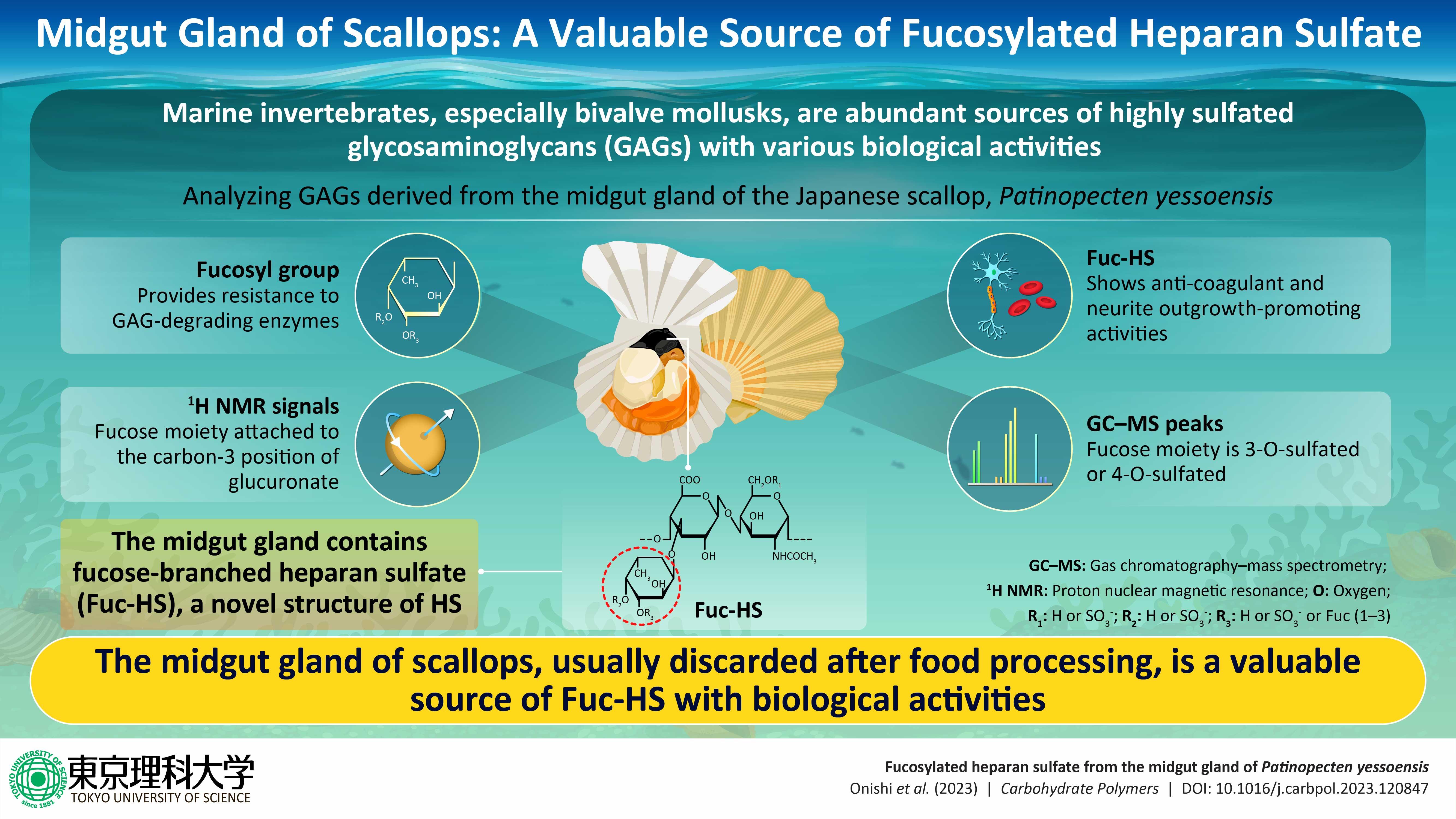2023.06.15 Thursday
Midgut Gland of Scallops: A Valuable Source of Fucosylated Heparan Sulfate
Researchers show that fucosylated heparan sulfate, a branched acidic glycosaminoglycan, exhibits anticoagulating and neurite outgrowth-promoting activities
Marine invertebrates, including bivalve mollusks like scallops, are potential sources of heparin or highly sulfated glycosaminoglycans (GAGs) with biological activities. Exploring them further, researchers from Japan and USA recently investigated the GAGs derived from the midgut gland of the Japanese scallop. They found that fucosylated heparan sulfate (Fuc-HS) from the midgut gland has anticoagulating and neurite outgrowth-promoting activities.

Glycosaminoglycans (GAGs), including chondroitin sulfate (CS), heparan sulfate (HS), heparin, and hyaluronan are linear and acidic polysaccharides found in the extracellular matrix of all animal tissues. GAGs are widely used as functional ingredients in health products, pharmaceuticals, and cosmetics, and are prepared from biological samples such as shark cartilage and porcine intestinal mucosa. Consequently, the demand for new sources of GAGs is ever-present. For example, the supply source of the anticoagulant heparin-generally prepared from porcine intestinal mucosa in China-was threatened by African swine fever in 2018.
GAGs derived from marine invertebrates-animals without a bony skeleton-such as bivalve mollusks are highly sulfated or branched with neutral sugars. These modifications enhance their properties and enable them to perform various biological activities. In fact, heparin-like polysaccharides with anticoagulant activity were identified from some kinds of bivalve mollusks.
In this light, a group of researchers led by Dr. Kyohei Higashi, Associate Professor at the Faculty of Pharmaceutical Sciences at the Tokyo University of Science (TUS), has investigated the structure and biological activities of GAGs derived from the midgut gland of the Japanese scallop, Patinopecten yessoensis, a bivalve mollusk.
Their work, made available online on 25th March 2023, will be published in Volume 313 of the Carbohydrate Polymers journal on 1st August 2023. It is co-authored by Dr. Takeshi Wada and Dr. Kazuki Sato of the TUS and Dr. Shinji Miyata of the Tokyo University of Agriculture and Technology.
Dr. Higashi briefly discusses the motivation behind the present research. "Scallops are among the most popular marine ingredients in Japan. While their adductor muscle and mantle are edible, their midgut gland, a potential cadmium accumulator, is usually discarded as waste during food processing. However, it may be a promising abundant source of GAGs, whose structures remain unexplored."
In this study, the researchers extracted crude GAGs from the midgut gland of the Japanese scallop, fractionated them by anion exchange chromatography, and analyzed their structures through high-performance liquid chromatography (HPLC), proton nuclear magnetic resonance (1H NMR), and gas chromatography-mass spectrometry (GC-MS) techniques. HPLC revealed that HS, which showed resistance to GAG-degrading enzymes such as chondroitinases and heparinases, is the major GAG present in the gland. However, its resistance to heparinases decreased upon mild acid hydrolysis, hinting at the presence of the fucosyl (Fuc) group. 1H NMR confirmed the same. It detected significant signals corresponding to the H-6 methyl proton of Fuc and small signals corresponding to H-2 or H-3 of glucuronate (GlcA) present in HS, showing that Fuc is attached to the C-3 position of GlcA. Furthermore, GC-MS detected peaks corresponding to 1, 3, 5-tri-O-acetyl-2, 4-di-O-methyl-L-fucitol and 1, 4, 5-tri-O-acetyl-2, 3-di-O-methyl-L-fucitol, enabling researchers to conclude that Fuc is 3-O- or 4-O-sulfated.
Lastly, the study highlights that Fuc-HS shows biological activities such as anticoagulation or blood clot prevention and neurite-a projection from the nerve cell-outgrowth promotion. "These findings indicate that the midgut gland of scallops is a valuable source of Fuc-HS with novel functions. A more detailed investigation of the structure and biological activities of Fuc-HS might reveal its other potential applications, similar to the fucosylated chondroitin sulfate (Fuc-CS) that shows antiviral, anti-diabetic, anti-tumor, and immunomodulatory effects," points out Dr. Higashi.
The researchers expect the present study to help facilitate the comprehensive analysis of the structure and functions of naturally occurring and biologically active GAGs derived from unutilized sources, which may provide hints for developing glycoside drugs.
Here's hoping for the discovery of more novel GAGs!
Reference
| Title of original paper | : | Fucosylated heparan sulfate from the midgut gland of Patinopecten yessoensis |
| Journal | : | Carbohydrate Polymers |
| DOI | : | 10.1016/j.carbpol.2023.120847 |
About The Tokyo University of Science
Tokyo University of Science (TUS) is a well-known and respected university, and the largest science-specialized private research university in Japan, with four campuses in central Tokyo and its suburbs and in Hokkaido. Established in 1881, the university has continually contributed to Japan's development in science through inculcating the love for science in researchers, technicians, and educators.
With a mission of "Creating science and technology for the harmonious development of nature, human beings, and society", TUS has undertaken a wide range of research from basic to applied science. TUS has embraced a multidisciplinary approach to research and undertaken intensive study in some of today's most vital fields. TUS is a meritocracy where the best in science is recognized and nurtured. It is the only private university in Japan that has produced a Nobel Prize winner and the only private university in Asia to produce Nobel Prize winners within the natural sciences field.
■
Tokyo University of Science(About TUS)

About Associate Professor Kyohei Higashi
from Tokyo University of Science
Dr. Kyohei Higashi has been an Associate Professor at the Department of Pharmacy at the Faculty of Pharmaceutical Sciences at the Tokyo University of Science since 2018. He completed his Ph.D. in pharmaceutical sciences from Chiba University. Over the last two decades, he has published 88 research articles, which have been cited more than 1,700 times. His major research area includes physical pharmacy and clinical and analytical biochemistry, with a focus on polyamines and glycosaminoglycans. He is also active in the fields of molecular biology, cell biology, and molecular genetics.
Official TUS website


